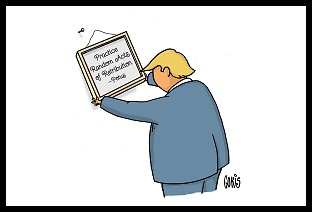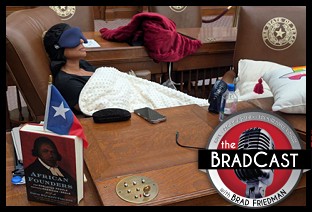Guest Blogged by Ernest A. Canning, with Brad Friedman
 In his March 31st article at Media Matters, Eric Boehlert contrasted the difference in corporate media coverage between Florida's 2000 Presidential election contest and Minnesota's 2008 U.S. Senate election contest. "Norm Coleman's a sore loser," Boehlert argued, and asked "Why won't the press say so?"
In his March 31st article at Media Matters, Eric Boehlert contrasted the difference in corporate media coverage between Florida's 2000 Presidential election contest and Minnesota's 2008 U.S. Senate election contest. "Norm Coleman's a sore loser," Boehlert argued, and asked "Why won't the press say so?"
He details the striking difference in the corporate media coverage of the two races, where Florida 2000 was both much closer and, as it would determine the Presidency of the United States, arguably more 'important' to get right, and yet the constant media framing continuously painted Al Gore as a "sore loser" for not bowing out 'gracefully' or 'admitting defeat' in the days following the razor-thin election (which, as we would learn later, Gore had actually won, having received more votes across the state of Florida [PDF] than George W. Bush, had the U.S. Supreme Court not kept the ballots from actually being counted).
But to go one further than Boehlert, we'd ask not why the media fail to describe Coleman as a "sore loser," but rather, why it is that --- particularly since Tuesday's final count of any remaining, lawfully cast, previously uncounted absentee ballots --- the media fail to describe Coleman as the loser at all, much less a sore one.
From the New York Times to AP to MSNBC, and even Democracy Now! et al, despite all countable ballots having now been counted, and clear rulings having been issued by both the MN Supreme Court and the bipartisan three-judge panel overseeing the contest, the media seem to have developed an aversion to using the "L" word --- loser --- in their coverage of the MN contest. Perhaps it's because they're listening to only one side of the argument (Coleman's), but the facts of the case, and the many clear court decisions, leave no question that Franken is the winner, and Coleman is the loser. So why won't they say so?...
It's Not a 'Lead', It's a 'Win'
Yesterday, The New Times reported "On Tuesday, after a seven-week case brought by Mr. Coleman and the counting of 351 absentee ballots that had been wrongly rejected, Mr. Franken's lead grew by 87 votes, to 312 votes." They also reported that "some issues remain to be decided" by the three-judge panel overseeing Coleman's Election Contest against Franken.
During her Apr. 8, 2009 interview of Minnesota Gov. Tim Pawlenty, Rachel Maddow compounded the Times' misreporting, by declaring that votes are "still being added," and that Al Franken was "ahead by 312 votes."
Both the Times and MSNBC got it wrong. Votes are not "still being added" and there are no issues still remaining before the three-judge panel.
In both the March 31, 2009, order [PDF], directing that 400 unopened absentee ballots be delivered to the court by Apr. 6, 2009, and in its Apr. 7, 2009, order [PDF] directing that 351 ballots be opened and counted, the three-judge panel stated that "any relief not fully set forth herein is denied." Other such "relief" would include Coleman's dubious double-count claim, which had been based on the speculative testimony of a single, thoroughly discredited, partisan witness.
It is probable that the three-judge panel will provide a written explanation of its denial of any other relief, as already stated, when it enters a final judgment. That could come any day now. Coleman's time to file an appeal will not commence until the final judgment is entered. But make no mistake. There are no more votes to be counted. 312 votes is the margin of victory for Al Franken over Norm Coleman.
No More Ballots Still to be Counted
Another misconception should be dispelled. As Pawlenty noted during the Apr. 8th interview with Maddow, the Governor cannot sign a certification until after Coleman either fails to timely appeal or the MN Supreme Court denies the appeal.
In the interview, Pawlenty alluded to Coleman attorney Ben Ginsberg's equal protection argument, and was evasive on whether he would delay certification if Coleman filed a petition with the U.S. Supreme Court. Pawlenty also questioned the validity of a decision issued last December, in which the MN Supreme Court refused to permit the opening and counting of erroneously rejected absentee ballots unless local officials, the Sec. of State and both candidates agreed. Pawlenty expressed the view that the U.S. Supreme Court might want to look at the question of whether the rights of voters to have their ballots counted is denied when it is dependent on the agreement of the candidates.
While the MN Supremes decision may have been a dubious one, Pawlenty's erroneous observations underscore why accurate media coverage is so vital. Any of those lawfully cast ballots not counted last December have now, finally, been counted. That's a point that Pawlenty might not have been able to mislead viewers about, had the corporate media done its job in accurately explaining what has gone on, rather than relying on one side's partisan --- and misleading --- talking points to drive their coverage.
The press has focused on that expedited December 2008 MN Supreme Court decision, which, while rejecting Coleman's effort (back when he felt he was winning) to keep erroneously rejected absentee ballots from being opened and counted, permitted officials to do so only where officials and the candidates agreed. The press has also focused on the state Supreme Court's rejection of Franken's request for immediate certification in Franken v Pawlenty.
But the Court's Mar. 6, 2009, opinion [PDF] in Coleman v. Ritchie has received scant attention.
In that ruling, the state Supreme Court, over a single dissenter, explained its December 2008 ruling. MN statutes, the Court ruled, prevent the local canvassing boards from opening erroneously rejected absentee ballots during a post election hand-count unless both candidates agree. However, those ballots may be examined for possible opening and counting after evidence is examined by a three-judge electon contest panel charged with correcting any such errors.
That has already happened.
Assuming Pawlenty's insinuation --- that the MN Supremes erred in their ruling specifying the conditions under which such incorrectly rejected absentee ballots could be opened and counted during a post-election hand-count --- that error was remedied when both sides were provided a full and fair opportunity to request the opening and counting of any such unopened ballots during the seven week contest trial.
Tuesday's ruling by the three-judge panel amounted to a judicial determination that there were precisely 351 previously unopened, lawfully cast absentee ballots that were erroneously rejected. They were opened, counted, added to the results. End of story. Or at least it should be, if the corporate media were bothering to pay attention.
Equal Protection Argument Similarly 'Dead in its Tracks'
And while there are no more ballots to be opened and counted, there are similarly no "equal protection" arguments with a legal leg to stand on --- a fact which is apparent, again, if one bothers to examine the legal decisions that have been made in the several MN cases over the last few months.
In the Coleman v Ritchie decision, the Court recited the four, clear conditions, under MN law, which must be satisfied before an absentee ballot envelope can be opened and the ballot counted:
(2) the voter's signature on the return envelope is the genuine signature of the individual who made the application for the absentee ballot, and the certificate of eligibility to vote by absentee ballot has been completed as prescribed in the directions for casting an absentee ballot;
(3) the voter is registered and eligible to vote in the precinct or has included a properly completed voter registration application in the return envelope; and
(4) the voter has not already voted, either in person or by absentee ballot.
On Feb. 13, 2009, the three-judge contest court rejected [PDF] Coleman's argument that unopened absentee ballots could be reviewed en masse simply by placing them under the various categories of erroneous rejection. The only method for a correct application of the above-listed, very specific standards, the court determined, is by examining each ballot and voter registration status individually.
It was this key ruling that led Coleman attorney Ben Ginsberg to claim that Minnesota's electoral system was "fatally flawed" because, he argued to the media, the standards had not been uniformly applied at the local level; that this lack of uniformity deprived Coleman of equal protection under the law. But because absentee ballots already counted have long since been separated from the return envelopes, Ginsberg's "fatally flawed" argument, if it were otherwise valid, would nullify the November 2008 election, forcing a second election. It also might nullify every other contest on the ballot, and just about every other race in the nation, for that matter.
We previously referenced Franken's argument that imperfect application of these clearly delineated standards by local election officials does not amount to a "constitutional violation." In Coleman v Ritchie the Minnesota Supreme Court, quoting a prior decision, agreed. They stated:
In The BRAD BLOG's Feb. 22, 2009, coverage, the claim was made that Coleman's election contest was "dead in its tracks" and the view was expressed that team Coleman simply "plods on, delaying the seating of a U.S. Senator at a time when every vote has become essential to the new administration's efforts to bring this nation back from the edge of an economic abyss."
Nothing that has transpired since the publication of that article warrants an alteration of that opinion...no matter what the corporate media may report --- or, in this case, fail to report.
===
Ernest A. Canning has been an active member of the California State Bar since 1977 and has practiced in the fields of civil litigation and workers' compensation at both the trial and appellate levels. He graduated from Southwestern University School of Law where he served as a student director of the clinical studies department and authored the Law Review Article, Executive Privilege: Myths & Realities. He received an MA in political science at Cal State University Northridge and a BA in political science from UCLA. He is also a Vietnam vet (4th infantry, Central Highlands 1968).


 Sunday 'Random Acts of' Toons
Sunday 'Random Acts of' Toons From CA's 'Nuclear Deterrence' Map to Newsom's Trolling to Trump's 'Fascist Theatre' and Beyond: 'BradCast' 8/21/25
From CA's 'Nuclear Deterrence' Map to Newsom's Trolling to Trump's 'Fascist Theatre' and Beyond: 'BradCast' 8/21/25 'Green News Report' 8/21/25
'Green News Report' 8/21/25
 On 'Americanism' and Trump's 'Stalinesque' Plot to Whitewash U.S. History: 'BradCast' 8/20/25
On 'Americanism' and Trump's 'Stalinesque' Plot to Whitewash U.S. History: 'BradCast' 8/20/25  Texas GOP Imprisons Dem State Lawmaker in State House Chamber: 'BradCast' 8/19/25
Texas GOP Imprisons Dem State Lawmaker in State House Chamber: 'BradCast' 8/19/25 'Green News Report' 8/19/25
'Green News Report' 8/19/25 Trump, Nazis and
Trump, Nazis and  Sunday '
Sunday ' Newsom's 'Election Rigging Response Act'; FCC's License Renewal for Sock-Puppeting Sinclair: 'BradCast' 8/14/25
Newsom's 'Election Rigging Response Act'; FCC's License Renewal for Sock-Puppeting Sinclair: 'BradCast' 8/14/25 'Green News Report' 8/14/25
'Green News Report' 8/14/25 140 New House Reps?: Moving Beyond the Gerrymandering Wars: 'BradCast' 8/13/25
140 New House Reps?: Moving Beyond the Gerrymandering Wars: 'BradCast' 8/13/25 FCC Renews Sinclair TV Licenses Despite Complaint from Petitioner Who Died Waiting
FCC Renews Sinclair TV Licenses Despite Complaint from Petitioner Who Died Waiting It's Not About the Rule of Law, It's About Authoritarian Control: 'BradCast' 8/12/25
It's Not About the Rule of Law, It's About Authoritarian Control: 'BradCast' 8/12/25 'Green News Report' 8/12/25
'Green News Report' 8/12/25 After Vaccine Cancels, CDC Shooting, Former Officials Want RFK Out: 'BradCast' 8/11/25
After Vaccine Cancels, CDC Shooting, Former Officials Want RFK Out: 'BradCast' 8/11/25 Sunday 'All's Well' Toons
Sunday 'All's Well' Toons 'Green News Report' 8/7/25
'Green News Report' 8/7/25 Trump Wars Against Greem Energy, Democracy on VRA's 60th: 'BradCast' 8/7
Trump Wars Against Greem Energy, Democracy on VRA's 60th: 'BradCast' 8/7 Media Conglomerates Continue Trump Capitulation: 'BradCast' 8/6/25
Media Conglomerates Continue Trump Capitulation: 'BradCast' 8/6/25 Banana Republican: Trump Shoots the Labor Statistics Messenger: 'BradCast' 8/5/25
Banana Republican: Trump Shoots the Labor Statistics Messenger: 'BradCast' 8/5/25 All's Fair in Love, War and, Apparently, Part-isan Gerrymandering: 'BradCast' 8/4/25
All's Fair in Love, War and, Apparently, Part-isan Gerrymandering: 'BradCast' 8/4/25 The Art of the Corrupt, Phony, Unlawful, Pretend Trade Deal: 'BradCast' 7/31/25
The Art of the Corrupt, Phony, Unlawful, Pretend Trade Deal: 'BradCast' 7/31/25 Battle Begins Against Trump EPA Climate Regulations 'Kill Shot': 'BradCast' 7/30/25
Battle Begins Against Trump EPA Climate Regulations 'Kill Shot': 'BradCast' 7/30/25 A Pu Pu Platter of Trump Corruption: 'BradCast' 7/29/25
A Pu Pu Platter of Trump Corruption: 'BradCast' 7/29/25 'Catastrophic' GOP Cuts to Medicaid, Medicare, ACA: 'BradCast' 7/28/25
'Catastrophic' GOP Cuts to Medicaid, Medicare, ACA: 'BradCast' 7/28/25
 VA GOP VOTER REG FRAUDSTER OFF HOOK
VA GOP VOTER REG FRAUDSTER OFF HOOK Criminal GOP Voter Registration Fraud Probe Expanding in VA
Criminal GOP Voter Registration Fraud Probe Expanding in VA DOJ PROBE SOUGHT AFTER VA ARREST
DOJ PROBE SOUGHT AFTER VA ARREST Arrest in VA: GOP Voter Reg Scandal Widens
Arrest in VA: GOP Voter Reg Scandal Widens ALL TOGETHER: ROVE, SPROUL, KOCHS, RNC
ALL TOGETHER: ROVE, SPROUL, KOCHS, RNC LATimes: RNC's 'Fired' Sproul Working for Repubs in 'as Many as 30 States'
LATimes: RNC's 'Fired' Sproul Working for Repubs in 'as Many as 30 States' 'Fired' Sproul Group 'Cloned', Still Working for Republicans in At Least 10 States
'Fired' Sproul Group 'Cloned', Still Working for Republicans in At Least 10 States FINALLY: FOX ON GOP REG FRAUD SCANDAL
FINALLY: FOX ON GOP REG FRAUD SCANDAL COLORADO FOLLOWS FLORIDA WITH GOP CRIMINAL INVESTIGATION
COLORADO FOLLOWS FLORIDA WITH GOP CRIMINAL INVESTIGATION CRIMINAL PROBE LAUNCHED INTO GOP VOTER REGISTRATION FRAUD SCANDAL IN FL
CRIMINAL PROBE LAUNCHED INTO GOP VOTER REGISTRATION FRAUD SCANDAL IN FL Brad Breaks PA Photo ID & GOP Registration Fraud Scandal News on Hartmann TV
Brad Breaks PA Photo ID & GOP Registration Fraud Scandal News on Hartmann TV  CAUGHT ON TAPE: COORDINATED NATIONWIDE GOP VOTER REG SCAM
CAUGHT ON TAPE: COORDINATED NATIONWIDE GOP VOTER REG SCAM CRIMINAL ELECTION FRAUD COMPLAINT FILED AGAINST GOP 'FRAUD' FIRM
CRIMINAL ELECTION FRAUD COMPLAINT FILED AGAINST GOP 'FRAUD' FIRM RICK SCOTT GETS ROLLED IN GOP REGISTRATION FRAUD SCANDAL
RICK SCOTT GETS ROLLED IN GOP REGISTRATION FRAUD SCANDAL VIDEO: Brad Breaks GOP Reg Fraud Scandal on Hartmann TV
VIDEO: Brad Breaks GOP Reg Fraud Scandal on Hartmann TV RNC FIRES NATIONAL VOTER REGISTRATION FIRM FOR FRAUD
RNC FIRES NATIONAL VOTER REGISTRATION FIRM FOR FRAUD EXCLUSIVE: Intvw w/ FL Official Who First Discovered GOP Reg Fraud
EXCLUSIVE: Intvw w/ FL Official Who First Discovered GOP Reg Fraud GOP REGISTRATION FRAUD FOUND IN FL
GOP REGISTRATION FRAUD FOUND IN FL

































